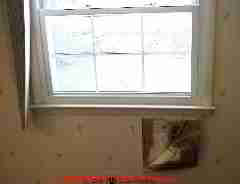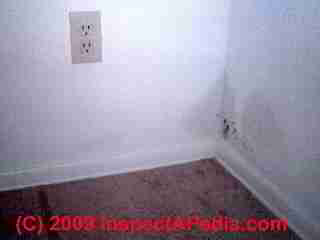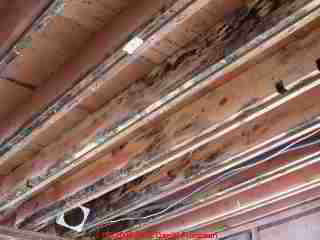 Big Mold Testing, Inspecting, & Cleanup Mistakes to Avoid
Big Mold Testing, Inspecting, & Cleanup Mistakes to Avoid
- POST a QUESTION or COMMENT about mold cleanup or mold testing mistakes you should avoid
Here we list big and costly mistakes that people make when cleaning up moldy buildings. We start with unnecessary mold testing and unnecessary professional mold remediation for small mold contamination areas. This article in our "How to Clean Mold" article series describes common mistakes people make when attempting to clean up mold.
Avoiding these mold cleanup errors can save you money and may also avoid dangerous side effects of bleach, mold chemicals, or ozone when improperly applied. Our page top photo shows mold growth behind wallpaper under a leaky window in a condominium in New Jersey. Just wiping off the wallpaper surface was not very helpful.
But the entire scope of this mold contamination was trivial - just about two square feet. Was mold testing needed? Mark Cramer assisted in development of this material.
InspectAPedia tolerates no conflicts of interest. We have no relationship with advertisers, products, or services discussed at this website.
- Daniel Friedman, Publisher/Editor/Author - See WHO ARE WE?
4. MOLD CLEANING MISTAKES people make when cleaning-up moldy building materials and moldy surfaces
[Click to enlarge any image]
This discussion lists common mold remediation or mold cleanup errors specific to attempts to clean mold from contaminated framing lumber or building sheathing such as plywood or pine boards used for subfloors or roofs.
Inadequate cleaning and cross contamination are the two most common mistakes we find when inspecting and testing sites to perform a post remediation clearance for mold cleanup.
Using bleaches, sprays, or ozone instead of cleaning are close behind in frequency of mistakes.
Other mold remediation errors such as performing only demolition and failing to clean up the dust and debris caused by that step, are important but are not discussed in this moldy wood cleaning document.
UNNECESSARY MOLD CLEANUP EXPENSE - using extreme, costly measures when inappropriate
Throwing money at mold: At MOLD / ENVIRONMENTAL EXPERT, HIRE ? we list the questions to ask when deciding just how far to go in inspecting and testing for problem mold in a building.
Small areas of mold: In short, if a mold problem is trivial, less than 30 square feet of contiguous mold, and if none of the risk factors that would suggest a thorough investigation apply, then mold cleanup can be handled as a normal building cleanup and renovation project.
Our photo (left) shows a small area of mold on drywall in an otherwise problem-free no-complaint home. Notice that dark line at right angles to the wall at lower left?
Furniture or boxes were stored in this corner, reducing air circulation and increasing condensation on the cooler wall corner - possibly the cause of mold growth on this surface. If there were no known or suspected leaks into the wall we probably have a small do-it-yourself or handyman mold cleanup project. The cost of professional testing and remediation are not justified.
For small area mold cleanup see DO IT YOURSELF MOLD CLEANUP and if you're not sure where to start,
see ACTION GUIDE - WHAT TO DO ABOUT INDOOR MOLD.
This article offers advice on cleaning mold found on surfaces of both finished & un-finished wooden building materials such as framing lumber (rafters, floor joists, wall studs), and building roof, wall, and floor sheathing such as plywood, tongue-and groove pine boards, and other structural wood surfaces in buildings.
We discuss the pros and cons of using fungicidal sealants and bleach on wood surfaces and give sources and list types of those products. We also discuss common errors made when cleaning wood surfaces, such as relying on bleach or performing expensive and unnecessary cleaning on cosmetic black mold on wood surfaces.
SMALL MOLD CLEANUP WARNING: even during a minor mold cleanup job, keep alert for the discovery that there was actually a large but previously unknown mold problem.
So if you are removing two square feet of moldy drywall and you find that the wall cavity side of the drywall is moldy you'll need to keep removing drywall until you've found a 24" or one stud (or joist) bay of clean drywall surface. If the size of that cleanup project grows to exceed 30 square feet of contiguous mold, stop the job and bring in an expert to give advice. Otherwise you risk spreading moldy dust and contaminating other building areas.
Cosmetic Mold or Non-Mold Stuff that is harmless: Also be sure you're not spending unnecessarily to clean up stuff that's not even mold (mineral efflorescence) or to clean up harmless cosmetic mold (which you may be able to determine by simple visual inspection).
See Stuff that is Not Mold for photos of things that are sometimes mistaken for mold.
See Molds that are Harmless - Cosmetic for photos and description of Blue Mold and Ceratocystis/Ophistoma - cosmetic black molds found on framing lumber.
COSMETIC MOLD WARNING: When we sampled at a chain of lumber supply stores and at some building sites we found that on treated lumber that has been prepared green and wet we sometimes find a mix of both harmless cosmetic mold and possibly harmful Aspergillus sp. or Penicillium sp. - so if these products are to be used indoors they might need to be surface-cleaned.
...
Continue reading at MOLD CLEANUP, SAFETY WARNINGS or select a topic from the closely-related articles below, or see the complete ARTICLE INDEX.
Or see these
Recommended Articles
- MOLD CLEANUP - MISTAKES to AVOID
- COSMETIC MOLD CLEANUP EXPENSE
- FAILURE TO PREVENT FUTURE MOLD
- INADEQUATE MOLD REMEDIATION PLAN
- INCOMPLETE MOLD CLEANUP, RELYING ON SPRAYS
- MOLD CLEANUP AREA CROSS CONTAMINATION
- RELYING on BLEACH on MOLD
- RELYING on OZONE to KILL MOLD
- UNNECESSARY MOLD CLEANUP COSTS
- MOLD CLEANUP GUIDE- HOW TO GET RID OF MOLD
- MOLD CLEARANCE INSPECTIONS
Suggested citation for this web page
MOLD CLEANUP - MISTAKES to AVOID at InspectApedia.com - online encyclopedia of building & environmental inspection, testing, diagnosis, repair, & problem prevention advice.
Or see this
INDEX to RELATED ARTICLES: ARTICLE INDEX to MOLD CONTAMINATION & REMEDIATION
Or use the SEARCH BOX found below to Ask a Question or Search InspectApedia
Ask a Question or Search InspectApedia
Try the search box just below, or if you prefer, post a question or comment in the Comments box below and we will respond promptly.
Search the InspectApedia website
Note: appearance of your Comment below may be delayed: if your comment contains an image, photograph, web link, or text that looks to the software as if it might be a web link, your posting will appear after it has been approved by a moderator. Apologies for the delay.
Only one image can be added per comment but you can post as many comments, and therefore images, as you like.
You will not receive a notification when a response to your question has been posted.
Please bookmark this page to make it easy for you to check back for our response.
IF above you see "Comment Form is loading comments..." then COMMENT BOX - countable.ca / bawkbox.com IS NOT WORKING.
In any case you are welcome to send an email directly to us at InspectApedia.com at editor@inspectApedia.com
We'll reply to you directly. Please help us help you by noting, in your email, the URL of the InspectApedia page where you wanted to comment.
Citations & References
In addition to any citations in the article above, a full list is available on request.
- In addition to citations & references found in this article, see the research citations given at the end of the related articles found at our suggested
CONTINUE READING or RECOMMENDED ARTICLES. - Our recommended books about building & mechanical systems design, inspection, problem diagnosis, and repair, and about indoor environment and IAQ testing, diagnosis, and cleanup are at the InspectAPedia Bookstore. Also see our Book Reviews - InspectAPedia.
- In addition to citations & references found in this article, see the research citations given at the end of the related articles found at our suggested
CONTINUE READING or RECOMMENDED ARTICLES.
Mark Cramer Inspection Services Mark Cramer, Tampa Florida, Mr. Cramer is a past president of ASHI, the American Society of Home Inspectors and is a Florida home inspector and home inspection educator. (727) 595-4211 mark@BestTampaInspector.com 11/06 and 04/2008
A BRIEF GUIDE to MOLD, MOISTURE, and YOUR HOME, [PDF] U.S. Environmental Protection Agency US EPA - includes basic advice for building owners, occupants, and mold cleanup operations. See http://www.epa.gov/mold/moldguide.htm
US EPA - MOLD REMEDIATION in SCHOOLS & COMMERCIAL BUILDINGS - - US EPA
US EPA - UNA BREVA GUIA a MOHO / HONGO - en Espanol
Allergies, Allergens, Allergy Testing in buildings - References & Products
"IgG Food Allergy Testing by ELISA/EIA, What do they really tell us?" Sheryl B. Miller, MT (ASCP), PhD, Clinical Laboratory Director, Bastyr University Natural Health Clinic - ELISA testing accuracy: Here is an example of Miller's critique of ELISA - www.betterhealthusa.com/public/282.cfm - Townsend Letter for Doctors and Patients
The critique included in that article raises compelling questions about IgG testing assays, which prompts our interest in actually screening for the presence of high levels of particles that could carry allergens - dog dander or cat dander in the case at hand.
- www.tldp.com/issue/174/IgG%20Food%20Allergy.html - contains similar criticism in another venue but interestingly by the same author, Sheryl Miller. Sheryl Miller, MT (ASCP), PhD, is an Immunologist and Associate Professor of Basic and Medical Sciences at Bastyr University in Bothell, Washington. She is also the Laboratory Director of the Bastyr Natural Health Clinic Laboratory.
Allergens: Testing for the level of exposure to animal allergens is discussed at http://www.animalhealthchannel.com/animalallergy/diagnosis.shtml (lab animal exposure study is interesting because it involves a higher exposure level in some cases
Allergens: WebMD discusses allergy tests for humans at webmd.com/allergies/allergy-tests
Fifth Kingdom, Bryce Kendrick, ISBN13: 9781585100224, - we recommend the CD-ROM version of this book. This 3rd/edition is a compact but comprehensive encyclopedia of all things mycological. Every aspect of the fungi, from aflatoxin to zppspores, with an accessible blend of verve and wit. The 24 chapters are filled with up-to-date information of classification, yeast, lichens, spore dispersal, allergies, ecology, genetics, plant pathology, predatory fungi, biological control, mutualistic symbioses with animals and plants, fungi as food, food spoilage and mycotoxins.
Fungi, Identifying Filamentous, A Clinical Laboratory Handbook, Guy St-Germain, Richard Summerbell, Star Publishing, 1996, ISBN 0-89863-177-7 (English)
Mycology, Fundamentals of Diagnostic, Fran Fisher, Norma B. Cook, W.B. Saunders Co. 1998, ISBN 0-7216-5006-6
- Carson, Dunlop & Associates Ltd., 120 Carlton Street Suite 407, Toronto ON M5A 4K2. Tel: (416) 964-9415 1-800-268-7070 Email: info@carsondunlop.com. Alan Carson is a past president of ASHI, the American Society of Home Inspectors.
Thanks to Alan Carson and Bob Dunlop, for permission for InspectAPedia to use text excerpts from The HOME REFERENCE BOOK - the Encyclopedia of Homes and to use illustrations from The ILLUSTRATED HOME .
Carson Dunlop Associates provides extensive home inspection education and report writing material. In gratitude we provide links to tsome Carson Dunlop Associates products and services.



